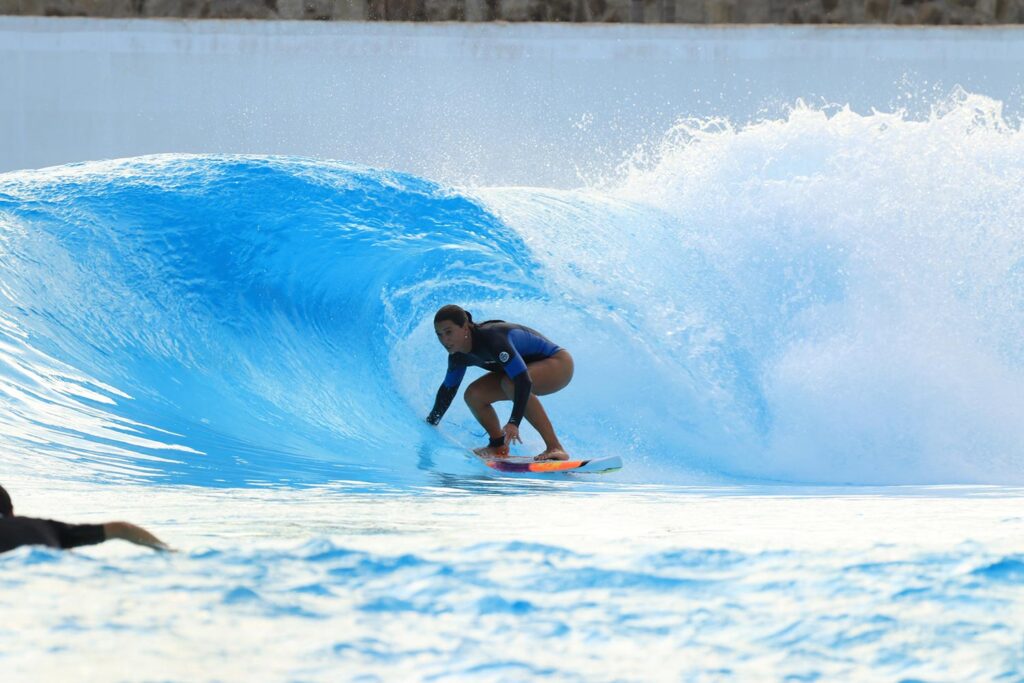
27 May, 2024
· 0 comments
Spain, land of sun, beach, and perfect waves for surfing. With over 12,000 kilometers of coastline, this country has become a must-visit destination for surf lovers across Europe. From the imposing waves of the north to the warm waters of the south, Spain offers a wide variety of spots that cater to all levels and tastes of surfers.
Discover with us the best waves in Spain, from the famous Mundaka and El Quemao to hidden gems in places like Cantabria, Asturias, Andalucía, and the Canary Islands.
The Canary Islands, and more specifically Lanzarote, not only host the best waves in Spain for surfing but, in our opinion, El Quemao is probably among the best waves in the world. Not in vain, this wave is nicknamed the European Pipeline. Without neglecting, of course, the wave of La Santa, another world-class wave that you can’t miss if you visit the island of Lanzarote.
El Quemao: Only for the Most Experienced
The wave of El Quemao is located in the famous municipality of La Santa, in the northwest of the island of Lanzarote. Considered one of the best waves in the world, it is reserved only for expert level surfers. On big days, if you have the sufficient level, you can get the waves of your life.
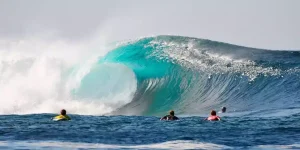
The town of La Santa in Lanzarote offers a wide range of services in the surrounding areas. Specifically, in the village of Famara, just a 5-minute drive away, you will find surf school in Lanzarote, or accommodations in a surf camp, among others.
Features of El Quemao
El Quemao is a wave that spits out huge and fast tubes, offering a vertical drop that will literally make you feel like you’re flying. The wave gives you the possibility to catch both lefts and rights, although its left is the most famous, comparable to the famous Pipeline in Hawaii.
The onshore wind at El Quemao blows from the east/southeast, and the best swell direction for the right is north, while for the left it’s northwest and west, needing at least medium-sized swells. Access to the wave is not too complicated; you enter the water from the port of the municipality of La Santa.
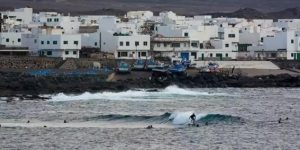
The best tide for surfing at El Quemao is during the mid to high tide. Its bottom is made of volcanic rock, and there is very little depth, so you must be careful. It can handle waves of up to 4 meters, but prepare yourself mentally before entering; otherwise, you could have a tough time.
The Left of La Santa
Like the wave at El Quemao, “La Santa” is located in the northwest of the island in the town that bears its name. This is another wave only suitable for very experienced surfers.
La Santa wave is one of the most popular on the island due to its consistency, it collects a lot of swell and is located in an area with a sharp volcanic rock bottom.
Characteristics of the Left of La Santa
Surfing at La Santa is reserved only for the most experienced surfers. It’s a peak that breaks both left and right, being considered one of the best waves for surfing in Spain, especially its powerful, fast, hollow, and short left.
Access to the wave is quite complicated, and you enter through the rocky point directly in front of the peak. On days with swell, use surf booties to avoid cutting yourself on the rocks. Leaving the wave requires the same caution.
The onshore wind at La Santa blows from the South/Southwest, also holding up with the Southeast and East. The best swell direction is North, Northeast, Northwest, and West. The best tide for surfing at La Santa is from mid to high tide.
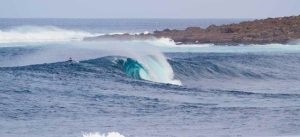
If you want to learn more about surfing in the Canary Islands, don’t miss our previous article: Guide to surfing on the best beaches of Lanzarote.
Cantabria is undoubtedly one of the must-visit destinations for surf lovers in Spain. It’s no wonder it hosts some of the best waves in the country, along with some of the best surf schools.
Here are the best waves for surfing in Cantabria. And if you’re one of those who likes to travel in a camper van to live the adventure to the fullest, we recommend Don Camper, a camper van rental agency in Cantabria.
El Brusco: The Wave that Challenges the Brave
Located in the Cantabrian town of Helgueras, belonging to the town of Noja, we find one of the jewels of surfing in Spain: El Brusco wave. This beach offers a unique experience for surf lovers, known for its impressive tubes that attract surfers from all over the country.
El Brusco is a beach break wave with a sandy bottom, famous for its demand and the power of its waves. In this spot, nationally renowned competitions have been held, such as the Red Bull Rivals, where surfers challenge the power of this wave.
Surfing at El Brusco requires preparation and skill. It’s a demanding wave that can destroy boards and leave novice surfers in trouble. Although it’s frequented by experienced locals, caution is recommended even for the most experienced surfers due to the strength and difficulty of the wave. El Brusco generates tubes with extraordinary force, making it an exciting challenge for those who dare to face it.
The onshore wind at El Brusco blows from the south/southeast, and the best tide is during high tide. The ideal swell direction is north/northwest. This wave needs a good size of swell to enjoy it to its fullest.
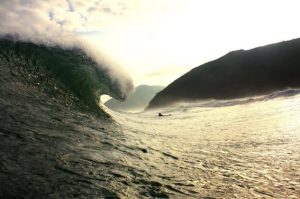
Cantabria, with its rugged and varied coastline, offers a paradise for surf lovers. And El Brusco is just one example of the many impressive waves that this region has to offer. Get ready to challenge your limits and enjoy an unforgettable experience at El Brusco, one of the best waves in Spain.
A notable feature of El Brusco is the consistency of its sandy bottoms, which ensures good surfing conditions. The best time to surf here is during autumn and winter, with south and southwest winds ideal for surf sessions.
Santa Marina: The Right
Santa Marina wave is undoubtedly one of the best in Spain for surfing. Located on the right side of the island bearing its name, this wave is famous for handling large swells, sometimes reaching heights of over 5 meters.
Santa Marina breaks near the rocks, opening towards Loredo Beach. Its initial part breaks over rocks, but as it progresses, it becomes a sandy bottom wave. Days with big swells are the best to enjoy this mythical wave in Cantabria, although on days with medium swells, you can also find very enjoyable rights.
Considered a “world-class” wave, Santa Marina is demanding both physically and technically, so it is not suitable for beginner surfers. Getting to the peak of this wave requires a good paddle, but the reward is manageable sections and quality tubes.
If you’re looking for the best waves in Spain for surfing, you can’t miss visiting Santa Marina Island. The best wind for surfing here comes from the Northeast, although it’s also possible to surf with Southeast and East winds. The ideal tide point is mid to high tide, although you can also surf at low tide, albeit with more risk due to exposed rocks.
Fortaleza Wave, Santoña: The Longest Wave in Spain
The Fortaleza wave in Santoña is recognized as the longest wave in Spain and is located in the Cantabrian town of Santoña. On its good days, it can offer rides of more than 900 meters, making it the longest in the country. Surfing it requires being very attentive to a swell forecast indicating significant swells.
It is a wave visited by surfers from all over Europe and frequented by locals in the area. On its optimal days, the wave is long, maneuverable, and can even offer some tubes. Although it is a demanding wave in terms of physical fitness due to its location amidst the currents of the Asón estuary, it is considered more of a “sweet spot.”
The paddle out to the peak can be tough, but once there, the wave offers an unforgettable experience. It needs a strong groundswell to break, and the onshore wind blows from the southwest or light west. The best tide point to surf it is low tide, and it requires high coefficients to reach its full potential.
Asturias is another surfing paradise in Spain and a must-visit for enthusiasts of this sport.
Rodiles Left
The left wave of Rodiles is one of the gems of surfing in Spain and one of the best left waves in the country. It is located at the mouth of the Villaviciosa estuary in Asturias. This wave generates fast, long, maneuverable, and hollow waves, offering an exciting challenge for surfers. However, it is not an easy wave to surf and requires good physical fitness. The currents can be strong, so reaching the peak can be quite a challenge.
Despite breaking over a sandbar, Rodiles left has quite a bit of water mass, which can result in serious wipeouts. The surroundings of this wave are impressive, surrounded by pine forests and with a wild appearance that adds excitement to the surfing experience here. Rodiles beach, located right at the mouth of the estuary, offers smaller waves, but none compare to the left of the estuary.
The wave needs big swells to break and is demanding due to the strong currents. The best wind for surfing at Rodiles is from the west/southwest, and the best tide point is low tide, although it can be surfed up to mid-tide.
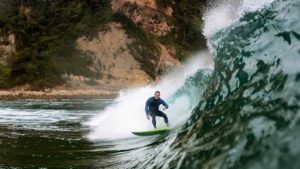
Mundaka: The Crown Jewel
The wave of Mundaka is undoubtedly one of the best waves in Spain for surfing, and it is even considered one of the best lefts in the world. It is not surprising that multiple events of the world surfing circuit have been held at this spot. Located at the mouth of the Urdaibai Estuary, in the picturesque town of Mundaka, this wave generates long, powerful, and perfectly tubular barrels. It has everything a surfer could wish for; on its good days, if you have the skill level, you can enjoy the best barrels of your life.
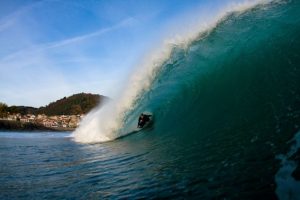
The Mundaka wave breaks over a sandbar formed by the accumulation of sediments and sand. Its bottom is variable, but when well-positioned, Mundaka becomes a magical and demanding wave. On its best days, Mundaka is not suitable for just any surfer. It requires a high level of physical and technical skill, as it is a complicated and difficult-to-read wave. It can reach up to five meters in height and have a length of over 400 meters of endless tubes. Few lefts in the world are as long and perfect as this one.
The best time to surf in Mundaka, considered one of the best waves in Spain, is during the autumn and winter months. The ideal wind is from the south or southwest, and the best tide time is from low to mid tide.
Meñakoz: The Force of the North
Meñakoz is one of the favorite destinations for surfers who love big waves. On its best days, this wave can reach heights of up to 8 meters, making it one of the most powerful and challenging in Spain.
With the ability to move tons of water, Meñakoz is known for its strength and power. To surf at Meñakoz, you need to be well-prepared and have a good gun (a special surfboard for big waves). This wave is not for beginners, as it breaks over a rocky bottom and can have serious consequences if you don’t have the right level.
The wind at Meñakoz blows from the south/southeast, and the best time to surf is during high tide. The ideal swell direction is North/Northwest.
Although Andalusia may not offer as much consistency as the North of Spain, we can still find some of the best waves in Spain for surfing.
El Palmar
El Palmar is a beach you can’t miss if you want to surf in Cádiz. With a very consistent and constant wave, it is undoubtedly the best wave in Andalusia for surfing. El Palmar’s wave will delight lovers of fast, hollow, and tubular waves. This beach break offers good barrels when there is enough size, making it one of the most highly rated waves in Spain for surfing.
The beach of El Palmar is considered one of the most pristine areas in the province and is one of the best beaches in Andalusia. With approximately 4 kilometers in length, this beautiful beach with golden and fine sand is located about 8 km from the town of Conil. Although it no longer fully retains its hippie essence, El Palmar Beach remains a special place where surf culture is deeply rooted.
The onshore wind at El Palmar usually blows from the east, but it also holds up with a gentle north wind. The ideal wave size for surfing at El Palmar in Cádiz ranges from 1 meter to 2 meters. There are also days with slightly smaller swells where you can find very fun waves. You can surf at El Palmar with almost all tide points, although with very high tide, the wave can generate some bounce. On big days, it’s better to catch it with water, as with low water, the wave can close out. Mid tide is usually the perfect point to enjoy good barrels.
Comments
Leave a comment
Your e-mail address will not be published. Required fields are marked with *.